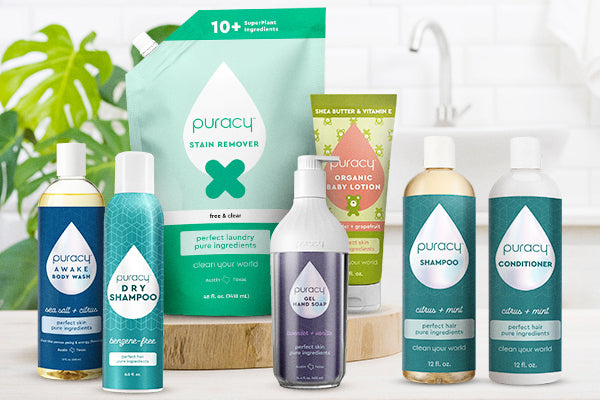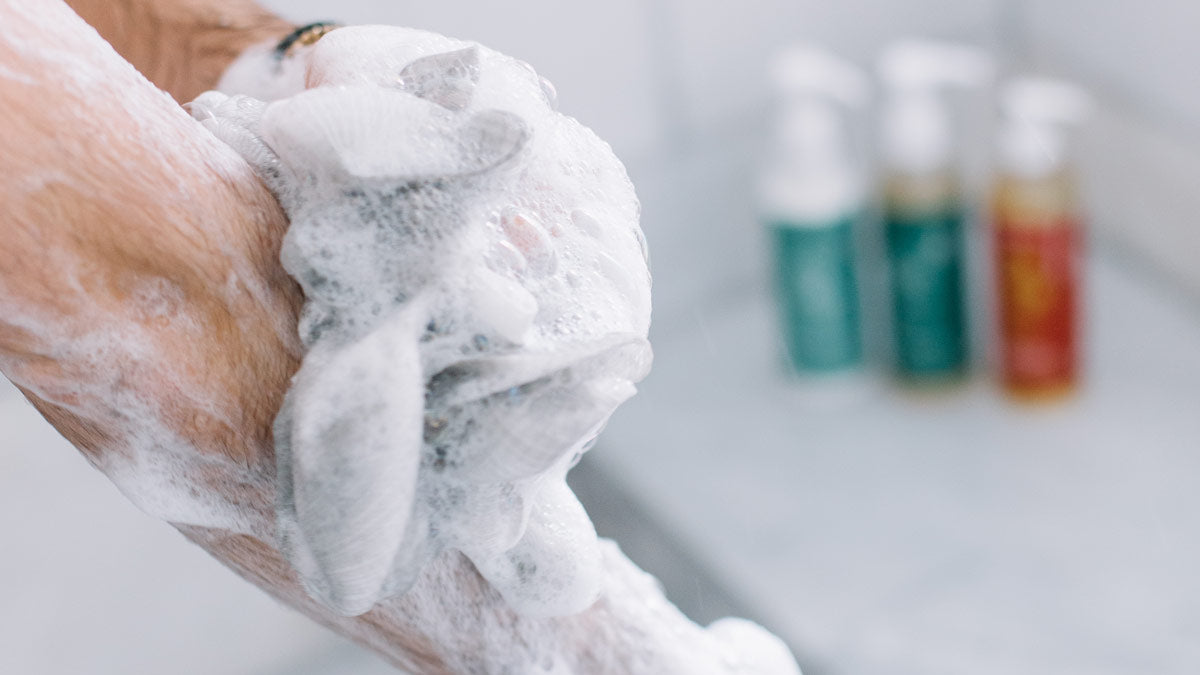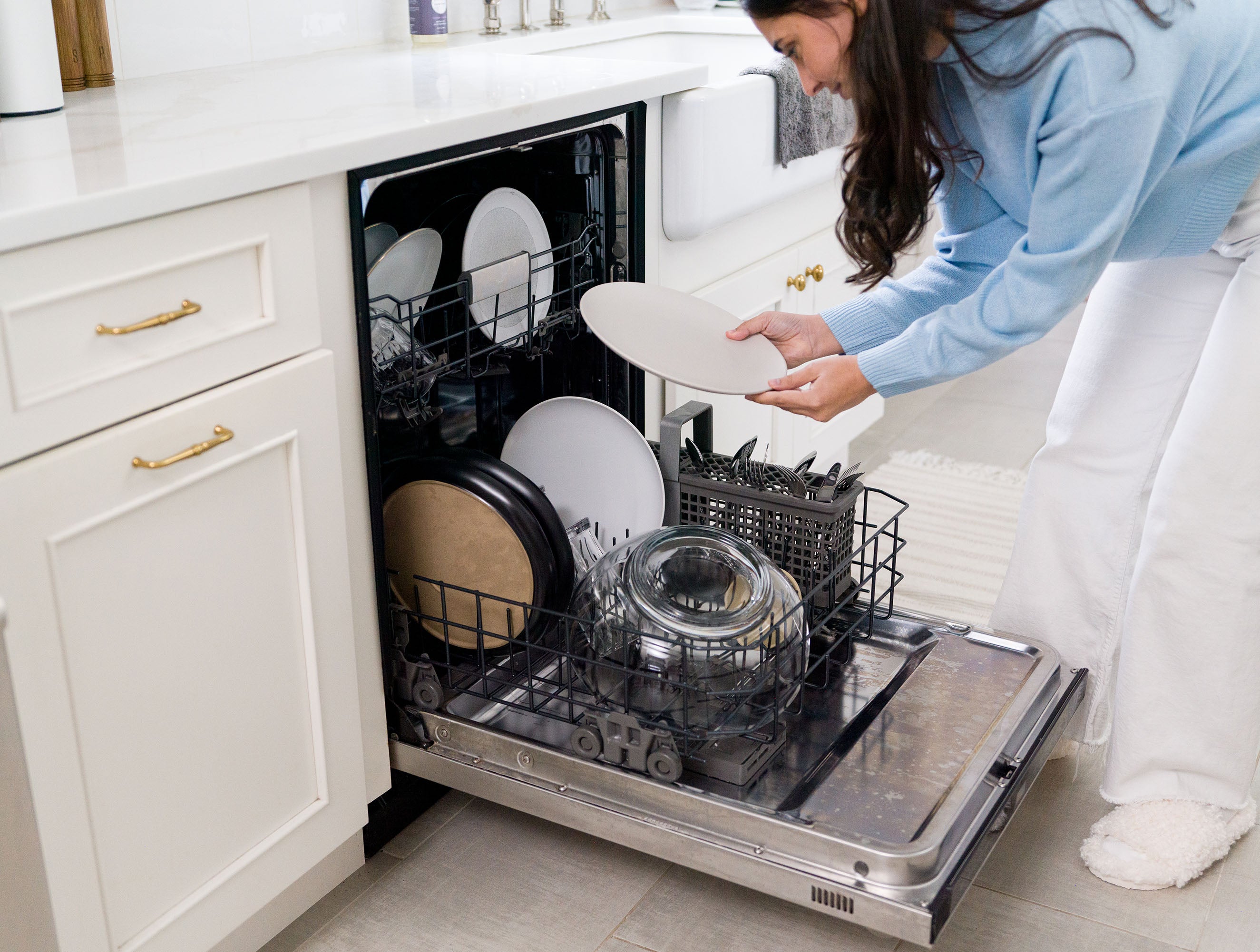
Shower Routine Steps & Products for Healthy Skin
How you shower matters. So if you're seeking glowing skin, don't miss out on these derm-approved shower routine steps & products!
SKIP TO BASIC STEPS:
It’s where you get energized, wash off the sweat after your workout, and unwind after a long day, but many people don't know how to shower correctly or make the most of their shower routine. In fact, when it comes to showering, there's a lot more to it than "wash and rinse."
In order to get glowing skin, try the following dermatologist-recommended shower routine steps.
Before You Take a Shower
1. Double Cleanse | 2. Cleansing Face Mask | 3. Brushing Hair | 4. Turn Down Temp | 5. Shower Filter

Adding a couple of minutes to your bath routine will go a long way towards improving your skin health.
-
Double Cleanse
Double cleansing originated in Korea and is widely encouraged by dermatologists worldwide. The first step involves using an oil-based cleanser to remove products like make-up and sunscreen. The next step will be discussed later as an after-shower routine using water-based products.
The oil-based cleanser will also help avoid getting “racoon eyes” when you pop out of the shower.
-
Use Clay, Charcoal, or Mud Masks for Cleansing
There are different types of masks depending on the purpose of using them. Clay, charcoal, or mud masks are used for cleansing, which is a great step to add before heading to shower.
The other type of facial masks is for moisturizing and leaving vitamins and essential nutrients on your skin. You can do this as an after-shower routine.
-
Brush Your Hair
While waiting for your mask to work its wonders, try combing your hair to untangle the strands. While we often comb the hair after showering, experts say hair is more prone to damage when combed wet.
Make sure you're brushing from the hair shaft and working your way downwards to the ends while removing snarls or bad tangles. A wide-toothed comb works best for detangling your hair.
-
Turn Down the Temperature
Scalding water lovers, we’ve got some news for you: Hot water temps strip away your skin's natural oils and can cause drier, flakier skin. This is especially troubling if you have dermatological issues or are dealing with dry skin in winter.
While some people prefer cold and others want warm water, the latter is recommended if you are going to sleep after. By the end of the day, the body’s core temperature decreases so a warm bath will help prep your body for a relaxing night.
For sensitive skin or for those with issues like dermatitis, keep the shower short and no longer than 10 minutes to avoid drying out your skin.
-
Invest in a Shower Filter
Municipal water that runs to your home may contain some forms of Volatile Organic Compounds (VOCs) and chlorine, which are harmful to your body. Experts say you don’t need to ingest these for them to be harmful.
VOCs can be cancerous while high chlorine levels may cause skin dryness and irritation. We are exposed to VOCs in our drinking and bathing water.
One way to address this is by the use of shower filters. Standard shower filters contain purifiers that rid of VOCs and other harmful chemicals, irritants, and contaminants like VOPs, chlorine, and metals.
If you notice hard water stains on your bathroom floor, it’s an indication that you definitely need a built in or in-line shower filter
During Your Shower
1. pH-Balanced Shower Products | 2. Shampoo | 3. Conditioner | 4. pH-balanced Body Wash | 5. Loofah | 6. Rinsing Thoroughly

How often you shower depends on you — there is no one right answer. It depends on several factors like how your body reacts to the weather, how active your lifestyle is, or if you go out too often.
There is no ideal frequency, but showering 5 minutes a day with a focus on the important parts of your body is enough.
Before you reach for a shampoo bottle, get your hair wet for 30-60 seconds. This will improve the cleaning process by loosening grime and product buildup.
-
Choose pH-Balanced Shower Routine Products
Though your hair tends to have a pH level of approximately 3.5, your scalp is around 5.5 (and extremely sensitive to changes). Try to find products that land somewhere in between these values.
Unfortunately, the majority of shampoo pH levels are between 6.0 and 7.0 – but you'll rarely see them listed on labels. If your scalp tends to dry out and you have dandruff, a switch to pH-balanced shampoo and conditioner might be the change you need.
With approximately the same acidity as your skin (5.5), Puracy Natural Shampoo and Conditioner have been specially formulated by biochemists to reduce irritation, dryness, and itchiness.
SKIP TO: Shower Mistakes and Misconceptions
-
Use Your Shampoo Correctly
Proper shampooing removes oil and hair product buildup, including the oil trapped in pores. How often you wash your hair will depend on how oily it is, according to the American Academy of Dermatology Association (AADA). Once a day is recommended for oily type hair and scalp.
Squirt a quarter-sized amount of shampoo into hands, lather, and work into your scalp along the roots.
Pay extra attention behind your ears and along your nape, which are usually the oiliest areas. Depending on your length of hair, you should massage your scalp and clean your hair for about 30 to 60 seconds before rinsing.
Find a sulfate-free shampoo to avoid eye and skin irritation. Look out for sodium lauryl sulfate (SLS) or sodium laureth sulfate (SLES) in the ingredients list. These provide the foaming texture, but it isn’t necessary in the cleaning process.
-
Condition Your Hair Every After Shampoo
Typically, you use a conditioner after using shampoo. While it isn’t a requirement, it’s an encouraged step to help lock in moisture and keep your hair from breaking easily.
Not only does it keep your hair shiny, but it also smoothens your cuticle and protects against oxidative stress. Spread it evenly from the hair shaft to the tips of your hair. Hair experts also advise to avoid conditioning the scalp as it may lead to product or grease build up.
Let the conditioner sit for approximately one to two minutes, and then rinse.
-
Use a pH-balanced Body Wash
Not only is pH-balanced body wash more convenient than bar soap, but it also tends to be more moisturizing.
Sensitive skin should avoid using "antibacterial" and "scented" soaps since these tend to contain ingredients like sulfates, triclosan, and synthetic fragrances which can trigger dermatological issues. Our 98.6% Natural Body Wash cleanses and restores your skin's pH balance without stripping away the natural oils that keep things smooth and hydrated.
-
How Much Body Wash Should I Use?
Most people use too much body wash. If you use too much, you may have a hard time washing it all off – and you can strip skin of its natural oils. A quarter-sized spurt should actually get most people clean.
Unless you're showering after an intense workout session, your arms and legs are usually fine with a water rinse. While lathering up, focus on the dirtiest spots of your body (e.g. underarms, feet, pelvic region).
Scrubbing with a loofah will not only help in exfoliation, but it can also help in blood circulation.
-
Use a Ph-Balanced Body Wash With a Loofah
Not only is pH-balanced body wash more convenient than bar soap, but it also tends to be more moisturizing.
Sensitive skin should avoid using "antibacterial" and "scented" soaps since these tend to contain ingredients like sulfates, triclosan, and synthetic fragrances which can trigger dermatological issues.
Most people use too much body wash when doing their shower routine. If you use too much, you may have a hard time washing it all off – and you can strip skin of its natural oils. A quarter-sized spurt should actually get most people clean.
Gentle rubbing with a circular motion is enough to take out dead skin cells.
-
Always Rinse Thoroughly
Cold water is ideal for sealing your hair cuticles – and that promotes bouncy, shiny hair. If you can't handle a blast of cold water, gradually turn the temperature down until it's comfortably cool.
After Your Shower
1. Dry Hair | 2. Double Cleanse | 3. Moisturize Face | 4. Apply Body Lotion

Follow these steps after your shower to lock in moisture and keep your hair healthy and strong.
-
Dry your hair the right way
Yes, there is a right way to let your hair dry. It’s easy to break strands when the hair is wet. The first thing you need to do is to squeeze out the excess water from the hair with your hands.
When that is done, use a soft hair towel and pat and gently squeeze the hair from the head to tips. Avoid using rough towels which may be the cause of tangles and breakage.
Try your best not to rub the towel on your hair. Repeat the above process until your hair is no longer dripping wet.
A microfiber towel is a good partner in your shower routine because it is soft and it has a better absorption power than most cotton towels.
-
Do the Second Part of the Facial Cleansing Routine
This is when you can do the second step of your double cleansing method. The American Academy of Dermatology Association recommends washing the face after a shower because hot water and steam will cause the face to be stripped off its natural oils.
To proceed, use your preferred gentle cleanser to clean your face at the sink. Avoid using harsh soaps with alcohol content. Make sure to do a gentle massage instead of scrubbing as the skin on the face can easily be irritated.
Rinse your face properly and use a face towel to pat dry or air dry your face.
-
Moisturize the Face and Neck Areas
You want your face to be a blank canvas for moisturizers and makeup. To avoid soap, dirt, and oil residue, hold off on using your face wash until after your hair is clean.
Instead of your regular soap, use a gentle water-based facial cleanser to complete your double cleansing routine.
-
Apply Lotion as Part of Your After Shower Routine
Board-certified dermatologist Dr. Julie Jackson MD, FAAD states that applying a natural skin moisturizer within 3 minutes of stepping out of the shower helps to prevent dehydration caused by "transepidermal water loss” as well as helping to restore the health of your skin barrier.
The thicker the consistency of the product, the better it can lock in the moisture. An organic lotion contains ingredients that block water evaporation, make the skin feel smooth, vitamins that reduce fine lines, soften the skin, and prevent it from going thick and dry.
If you have skin allergies or skin issues like eczema, a lotion with colloidal oatmeal and a thick consistency can help relieve itching.
Common Shower Mistakes and Misconceptions

Avoid these common mistakes before and after your shower to ensure soft, glowing skin and healthy hair.
-
Misconception #1: Sunscreen Is Only Necessary If You’re Going Outside
Apply your sunscreen, even if you aren’t going out. Chances are, parts of your house will be drenched in sun. You can also be exposed through the windows which UVA rays can penetrate.
Find a broad-spectrum sunscreen that protects you from UVA and UVB rays. Check for a sunscreen with an SPF of 50, which offers more protection.
If you will be swimming or will be drenched in water, there are water-resistant sunscreens that you can reapply after 30-40 minutes of use.
-
Misconception #2: You Can Use the Same Towel For Your Face and Body
It’s highly encouraged to use a separate towel for your face, especially if you are having trouble with acne.
Dermatologists say there may be a transfer of bacteria that are specific to the body and not to the face. If you’re not keen on keeping two towels, you can air dry the face instead.
Air drying your face is not only a good chance to skip another towel for laundry, but it also avoids the roughness of the towel on the face.
-
Misconception #3: Loofahs Don’t Need to Be Washed
Loofahs can harbor bacteria, yeast, and mold. You can repurchase them every month – or use your hands/a clean washcloth instead.
-
Misconception #4: Shaving Can Be Done Without Moisturization
Moisturizing after shaving your face or body is essential to keeping your skin and pores healthy and clean, especially during colder months when skin can get especially dry. Be sure to also regularly change out disposable razors and razor blades to avoid bacteria growth and mold.
You Deserve a Natural, Plant-Powered Shower Routine



























